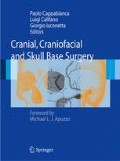Abstract
The orbitozygomatic (OZ) approach is an extension of the basic frontotemporal (FT) approach, which is associated with an OZ osteotomy and eventually with zygomatic arch resection. We emphasize that the basic FT approach, for us as for other authors, always includes resection of the sphenoid bridge (frontotemporopterional craniotomy).
Access this chapter
Tax calculation will be finalised at checkout
Purchases are for personal use only
Preview
Unable to display preview. Download preview PDF.
References
McArthur LL (1912) An aseptic surgical access to the pituitary body and its neighborhood. JAMA 58:2009–2011
Frazier CH (1913) An approach to the hypophysis through the anterior cranial fossa. Ann Surg 57:145–152
Yasargil MG (1969) Microsurgery applied to neurosurgery. Thieme, Stuttgart, pp 119–143
Yasargil MG, Fox JL, Ray MW (1975) The operative approach to aneurysms of the anterior communicating artery. In: Krayenbhl H (ed) Advances and technical standards in neurosurgery, vol. 2. Springer, Vienna New York, pp 113–170
Jane JA, Park TS, Pobereskin LH et al (1982) The supraorbital approach. Technical note. Neurosurgery 11(4):537–542
Pellerin P, Lesoin F, Dhellemmes P et al (1984) Usefulness of the orbitofrontomalar approach associated with bone reconstruction for frontotemporosphenoid meningiomas. Neurosurgery 15(5):715–718
Hakuba A, Liu S, Nishimura S (1986) The orbitozygomatic infratemporal approach. A new surgical technique. Surg Neurol 26:271–276
Al-Mefty O (1987) Supraorbital-pterional approach to skull base lesions. Neurosurgery 21(4):474–477
Aziz KMA, Froelich SC, Cohen PL et al (2002) The onepiece orbitozygomatic approach: the MacCarty burr hole and the inferior orbital fissure as keys to technique and application. Acta Neurochir (Wien) 144(1):15–24
Delashaw JB Jr, Tedeschi H, Rhoton AL Jr (1992) Modified supraorbital craniotomy: Technical note. Neurosurgery 30(6):954–956
Lemole GM Jr, Henn JS, Zabramski JM, Spetzler RF (2003) Modifications to the orbitozygomatic approach. A technical note. J Neurosurg 99(5):924–930
Pieper DR, Al-Mefty O (1999) Cranio-orbito-zygomatic approach. Oper Tech Neurosurg 2(1):2–9
Sekhar LN, Janecka IP, Jones NF (1988) Subtemporal-infratemporal and basal subfrontal approach to extensive cranial base tumours. Acta Neurochir (Wien) 92(1–4):83–92
Zabramski JM, Kiris T, Sankhla SK et al (1998) Orbitozygomatic craniotomy. Technical note. J Neurosurg 89(2):336–341
Hayashi N, Hirashima Y, Kurimoto M et al (2002) One-piece pedunculated frontotemporal orbitozygomatic craniotomy by creation of a subperiosteal tunnel beneath the temporal muscle: technical note. Neurosurgery 51(6):1520–1523
Balasingam V, Noguchi A, McMenomey SO, Delashaw JB Jr (2005) Modified osteoplastic orbitozygomatic craniotomy. Technical note. J Neurosurg 102(5):940–944
Miller ML, Kaufman BA, Lew SM (2008) Modified osteoplastic orbitozygomatic craniotomy in the pediatric population. Childs Nerv Syst 24(7):845–850
Fujitsu K, Kuwarabara T (1985) Zygomatic approach for lesions in the interpeduncular cistern. J Neurosurg 62:340–343
Ikeda K, Yamashita J, Hashimoto M, Futami K (1991) Orbitozygomatic temporopolar approach for a high basilar tip aneurysm associated with a short intracranial internal carotid artery: a new surgical approach. Neurosurgery 28:105–110
Sindou M, Emery E, Acevedo G, Ben David U (2001) Respective indications for orbital rim, zygomatic arch and orbito-zygomatic osteotomies in the surgical approach to central skull base lesions. Critical, retrospective review in 146 cases. Acta Neurochir (Wien) 143(10):967–975
Al-Mefty O, Anand VK (1990) Zygomatic approach to skull-base lesions. J Neurosurg 73(5):668–673
Uttley D, Archer DJ, Marsh HT et al (1991) Improved access to lesions of the central skull base by mobilization of the zygoma: experience with 54 cases. Neurosurgery 28(1):99–104
Di Rienzo A, Ricci A, Scogna A et al (2004) The openmouth fronto-orbitotemporozygomatic approach for extensive benign tumors with coexisting splanchnocranial and neurocranial involvement. Neurosurgery 54(5):1170–1179
Schwartz MS, Anderson GJ, Horgan MA et al (1999) Quantification of increased exposure resulting from orbital rim and orbitozygomatic osteotomy via the frontotemporal transsylvian approach. J Neurosurg 91:1020–1026
Gonzalez LF, Crawford NR, Horgan MA et al (2002) Working area and angle of attack in three cranial base approaches: pterional, orbitozygomatic, and maxillary extension of the orbitozygomatic approach. Neurosurgery 50(3):550–557
Tanriover N, Ulm AJ, Rhoton AL Jr et al (2006) One-piece versus two-piece orbitozygomatic craniotomy: quantitative and qualitative considerations. Neurosurgery 58(4 Suppl 2):ONS229–237
Feneis H, Dauber W (2000) Pocket atlas of human anatomy, 4th edn. Thieme, Stuttgart New York, pp 9–34, 54–55, 78–82, 322–332
Rhoton AL (2002) The anterior and middle cranial base. Neurosurgery 51(Suppl 1):273–302
Lyons BM (1998) Surgical anatomy of the skull base. In: Donald PJ (ed) Surgery of the skull base. Lippincot-Raven Philadelphia, pp 15–30
Rhoton AL (2002) The orbit. Neurosurgery 51(Suppl 1):303–334
Chicoine MR, van Loveren HR (2000) Surgical approaches to the cavernous sinus. In: Robertson JT, Coakhan HB, Robertson JH (eds) Cranial base surgery. Churchill Livingstone, London, pp 171–185
Yasargil MG, Reichman MV, Kubik S (1987) Preservation of the frontotemporal branch of the facial nerve using the interfascial temporalis flap for pterional craniotomy. Technical article. J Neurosurg 67(3):463–466
Coscarella E, Vishteh AG, Spetzler RF et al (2000) Subfascial and submuscular methods of temporal muscle dissection and their relationship to the frontal branch of the facial nerve. Technical note. J Neurosurg 92(5):877–880
Oikawa S, Mizuno M, Muraoka S, Kobayashi S (1996) Retrograde dissection of the temporalis muscle preventing muscle atrophy for pterional craniotomy. Technical note. J Neurosurg 84(2):297–299
Shimizu S, Tanriover N, Rhoton AL Jr et al (2005) The Mac-Carty keyhole and inferior orbital fissure in orbitozygomatic craniotomy. Neurosurgery 57(Suppl 1):152–159
Noguchi A, Balasingam V, Shiokawa Y et al (2005) Extradural anterior clinoidectomy. Technical note. J Neurosurg 102(5):945–950
Dolenc VV (1999) A combined transorbital-transclinoid and transsylvian approach to carotid-ophthalmic aneurysms without retraction of the brain. Acta Neurochir Suppl 72:89–97
Kawase T, Shiobara R, Toya S (1991) Anterior transpetrosal-transtentorial approach for sphenopetroclival meningiomas: surgical method and results in 10 patients. Neurosurgery 28:869–876
Day JD, Giannotta SL, Fukushima T (1994) Extradural temporopolar approach to lesions of the upper basilar artery and infrachiasmatic region. J Neurosurg 81(2)230–235
Author information
Authors and Affiliations
Editor information
Editors and Affiliations
Rights and permissions
Copyright information
© 2010 Springer-Verlag Italia
About this chapter
Cite this chapter
Galzio, R.J., Tschabitscher, M., Ricci, A. (2010). Orbitozygomatic Approach. In: Cappabianca, P., Iaconetta, G., Califano, L. (eds) Cranial, Craniofacial and Skull Base Surgery. Springer, Milano. https://doi.org/10.1007/978-88-470-1167-0_6
Download citation
DOI: https://doi.org/10.1007/978-88-470-1167-0_6
Publisher Name: Springer, Milano
Print ISBN: 978-88-470-1166-3
Online ISBN: 978-88-470-1167-0
eBook Packages: MedicineMedicine (R0)

